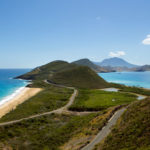Riga, Latvia: Pride and Courage
(Temporary story adapted from a 2007 report by Stuart Haggis of Passport Magazine)
Thanks to the combined appeal of a striking medieval Old Town, some of the world’s best-preserved Art Nouveau buildings, and neighborhoods of charming 19th Century wooden architecture, Riga’s historical center has been listed by UNESCO as a protected World Heritage site. Riga is also a city of culture, fashion and nightlife. It’s an eclectic mix of chic Scandinavian style, old Soviet severity, and new Russian ambition.
No stranger to conflict, Latvia declared its independence in 1918 after more than 700 years of occupation by the likes of Germany, Poland, Russia, and Sweden, but this freedom was short-lived. In 1939, at the brink of World War II, Germany and the Soviet Union signed a non-aggression pact, but in a secret protocol Hitler and Stalin had also agreed which countries they’d carve up and divide between them. This paved the way for Latvia, and the neighboring Baltic States of Estonia and Lithuania, to become annexed as Soviet republics.
In 1941, Germany revoked on the deal by invading. Altogether, it’s estimated that Latvia lost half-a-million people during World War II, including virtually all of its 90,000-strong Jewish population. After the defeat of the Nazis, the Soviet Union resumed control over Latvia. During these turbulent years, Riga’s Freedom Monument became a focal point for defiant nationalist demonstrations. Erected in 1935 by Latvian architect Karlis Zale, it features a slender column topped by the statue of a woman known as Milda. Those placing flowers here during Soviet times risked arrest and deportation to Siberia. Today it’s guarded by a pair of Latvian soldiers who rarely look old enough to shave, let alone shoot. For a graphic overview of this period, visit the Occupation Museum of Latvia, documenting its seizure and occupation from 1940 to 1991.
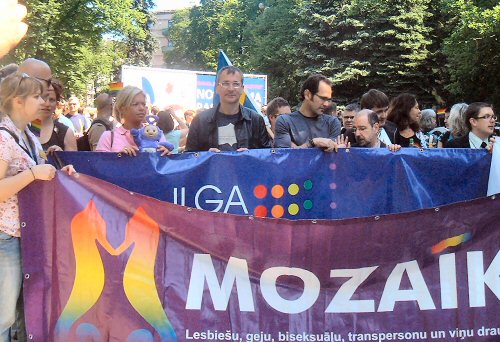 When the Soviet Union disbanded, Latvia once again declared its independence in 1991, and joined the European Union in 2004. Gay Pride had much opposition in the years before 2007 when Riga Pride happened peacefully and successfully as 400+ LGBT citizens and supporters–including straight Latvians and foreign activists–paraded in a cordoned off park for a show of color, music and speeches.
When the Soviet Union disbanded, Latvia once again declared its independence in 1991, and joined the European Union in 2004. Gay Pride had much opposition in the years before 2007 when Riga Pride happened peacefully and successfully as 400+ LGBT citizens and supporters–including straight Latvians and foreign activists–paraded in a cordoned off park for a show of color, music and speeches.
From 2006, the event was officially known as Riga Pride and Friendship Days, expanding the program beyond a parade to include a church service as well as seminars on LGBT rights but it was disrupted by anti-gay right-wing protesters from a radical group called ‘No Pride’, among others. The European Council was supportive and issued its disappointment at the failure of Riga police to adequately protect the parade. Nevertheless, Riga Pride took place in Riga in 2007 and 2008.
In 2009 another march was allowed by the local superior court. This was the first ‘Baltic Pride’ protected hundreds of riot police who kept protestors at a distance. It rotates annually among each Baltic state capital in cooperation with the Lithuanian Gay League, the Estonian LGBT Association and their local Pride events.
At the 2012 Baltic Pride, 400 people marched in support of LGBT rights in Latvia, joining them were US diplomats showing support. In 2015 the parade took place as part of the Europride event in Riga, the first time the pan-European LGBT rights week came to a post Societ country.
Human Rights activists aside, what about the rest Riga?
Passport Magazine author Stuart Haggis continued: I traveled to Riga with a party of gay journalists from England, Ireland, and Germany as guests of Mozaika. Oour names and itinerary had been leaked to No Pride, so we arrived to see all these details in a salacious front page article in Latvia’s right-wing newspaper Ritdiena, whose millionaire publisher Igors Masiakovs is coincidentally the chair of the anit-gay ‘No Pride’ group. Despite this turn of events, none of us encountered any problems for the duration of our stay. Instead, what I found was a genuine air of welcome and tolerance.
We enjoyed a stroll around the fairy-tale Old Town, where many of the medieval buildings have a history infused with folklore. 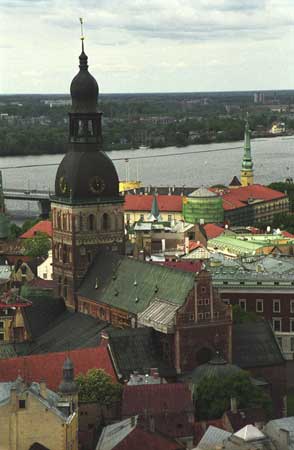 The imposing Doma Cathedral, (photo left) built in the 13th Century, may be the largest medieval church in the Baltics, but nearby St. Peter’s Church tells a more colorful tale. Thanks to its 123m wooden spire, St. Peter’s was until recently the tallest wooden building in Europe, but this spire also proved to be the core of St. Peter’s bad luck. The spire first collapsed in 1666 after being struck by lightning. The builders who reconstructed it dropped a wine glass from the top, claiming that many fragments of broken glass would symbolize the tower’s longevity. Alas the glass landed on bales of straw, a ceremonial misfortune reflected by the fact that the spire burnt down a year later.
The imposing Doma Cathedral, (photo left) built in the 13th Century, may be the largest medieval church in the Baltics, but nearby St. Peter’s Church tells a more colorful tale. Thanks to its 123m wooden spire, St. Peter’s was until recently the tallest wooden building in Europe, but this spire also proved to be the core of St. Peter’s bad luck. The spire first collapsed in 1666 after being struck by lightning. The builders who reconstructed it dropped a wine glass from the top, claiming that many fragments of broken glass would symbolize the tower’s longevity. Alas the glass landed on bales of straw, a ceremonial misfortune reflected by the fact that the spire burnt down a year later.
More lightning strikes followed, including one in 1721 that resulted in another collapse. Another incarnation of the spire was destroyed by artillery fire in 1941 during World War II. It was finally rebuilt in 1973 by Soviet engineers. Upon completion they repeated the glass dropping ceremony, fortunately with smashing results this time.
Another Gothic gem to suffer during World War II was the Blackheads House. Dating back to 1334, it was acquired by the Blackheads Merchant Guild to house unmarried foreign “merchant bachelors” whenever they traveled to Riga. It was known for its wild parties—decorating a tree with flowers for one such party in 1510 is widely considered to be the origin of the modern tradition of decorating a Christmas tree. Destroyed in 1941, Blackheads House was rebuilt to celebrate Riga’s 800th birthday in 2001.
One of three adjacent houses known collectively as the Three Brothers is now reputed to be the oldest surviving building in Riga. Containing a small architecture museum, all three are delightfully handsome and photogenic.
Although Riga was once a fortified city, today only a few small sections remain. Powder Tower, now housing the Latvian Museum Of War, is the best preserved; while Swedish Gate, built into the city wall in 1698 during Swedish rule, is the oldest remaining portion.
A legend tells of a Latvian beauty who fell in love with a Swedish soldier. Planning to elope, they arranged to meet here just before midnight. The young lady was late and arrived to find the gate locked, so she couldn’t meet her love. More tragic was the fact that her father, having discovered the plan, caught up with her and angrily sealed her alive into the wall. Locals believe they can still hear her crying. Nearby bars and restaurants have capitalized on this tale, becoming popular places for romantic dates—but if you plan a liaison with a dashing soldier hereabouts, make sure you’re not late!
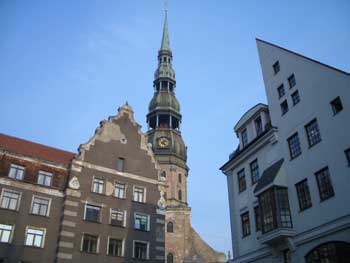 North of the Old Town is a neighborhood that boasts hundreds of examples of astonishingly effervescent Jugendstil buildings. Literally meaning “youth style,” this Art Nouveau splinter movement is sometimes referred to locally as Latvia Romantic. Either way, Riga boasts a higher concentration of this architectural style than any other metropolitan city center in the world.
North of the Old Town is a neighborhood that boasts hundreds of examples of astonishingly effervescent Jugendstil buildings. Literally meaning “youth style,” this Art Nouveau splinter movement is sometimes referred to locally as Latvia Romantic. Either way, Riga boasts a higher concentration of this architectural style than any other metropolitan city center in the world.
Built at the turn of the 19th Century, they’re adorned by a wealth of details including wailing heads and nubile naked ladies draped around columns. The most celebrated stretch is along Alberta iela, where many of the buildings were designed by Mikhail Eisenstein, father of filmmaker Sergei Eisenstein, who directed the 1925 Russian masterpiece Battleship Potemkin.
Riga also has one of the highest concentrations of wooden architecture of any European capital. Significant neighborhoods include Kipsala and Agenskalns where two story wooden houses were built in the 19th Century for immigrant Russian workers. The grandest and best-restored examples, however, are to be found in the nearby spa town of Jurmala. Regarded as Latvia’s equivalent to Beverly Hills, to me this upscale seaside resort is more reminiscent of Desperate Housewives and Wisteria Lane.
Some people think of Latvia as a gay destination. Based in Riga, PinkBaltics.com is the region’s first gay travel agency. The company’s charming young director, Paulius, readily admits that Latvia isn’t known as the most open or gay-friendly destination, especially when compared to cities like Paris or New York, but his aim is to take gay visitors to the places that are welcoming. Although they can arrange everything from treatments at luxurious spa resorts, to airport transfers in a limousine accompanied by champagne and your very own male stripper, surprisingly it’s the adrenaline-fueled activities that are most popular among gay visitors.
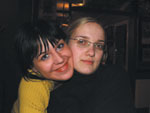
Look up the definition of “Pride” in a dictionary, and it will likely begin by describing a sense of one’s own dignity, value, or self-respect, or the pleasure or satisfaction taken in an achievement, possession, or association. The definition becomes somewhat tainted once religion is added to the equation. In Christianity, for example, Pride is one of the seven deadly sins. For the gay community, Pride has its own special meaning.
Riga, while providing a reminder of the politics of Pride, also provides a curious and engaging mix of attractions and activities. If travel really does broaden the mind, then traveling here might just play a part in broadening Latvia’s outlook as well.
By Stuart Haggas, edited by GlobalGayz
June, 2007/2017
From; PASSPORT MAGAZINE
http://www.passportmagazine.com/48/current.php




